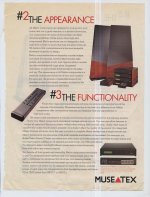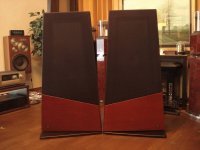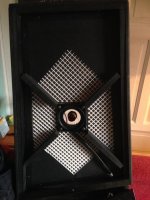In contemplating the advantages of electrostatic speakers over conventional speakers I am curious to hear any opinions of the following speaker design:
A low mms mylar panel say 500mm x 500mm with a pair of low mass voicecoils, one positioned on each side in the center of the mylar sheet -- presumably much smaller than the ones found on a conventional cone speaker. Some sort of structure, or cabling extending from a perimeter frame, suspends electromagnetic motors -- similar to a conventional driver just two of them, on each side of the sheet -- which provide the positive and negative forces to actuate the voice coils. The motors would have to be attached and implemented in such a way that they don't contribute to the mass of the diaphragm, and that their positive and negative strokes are equal. The dual opposing voice coils work in a similar fashion to an electrostatic stator in that when one is positive the other is negative yielding an equal dipolar response front and back. The advantages are very high transient response, very low distortion, efficient operation, and greater excursion and force than electrostatic stators are able to achieve without the risk of arcing, thus permitting much higher spl output. In addition this seems simpler and cleaner than a planar magnetic design in that much smaller/fewer and thus more efficient magnets could be used to achieve the equal output levels and likely greater performance.
A low mms mylar panel say 500mm x 500mm with a pair of low mass voicecoils, one positioned on each side in the center of the mylar sheet -- presumably much smaller than the ones found on a conventional cone speaker. Some sort of structure, or cabling extending from a perimeter frame, suspends electromagnetic motors -- similar to a conventional driver just two of them, on each side of the sheet -- which provide the positive and negative forces to actuate the voice coils. The motors would have to be attached and implemented in such a way that they don't contribute to the mass of the diaphragm, and that their positive and negative strokes are equal. The dual opposing voice coils work in a similar fashion to an electrostatic stator in that when one is positive the other is negative yielding an equal dipolar response front and back. The advantages are very high transient response, very low distortion, efficient operation, and greater excursion and force than electrostatic stators are able to achieve without the risk of arcing, thus permitting much higher spl output. In addition this seems simpler and cleaner than a planar magnetic design in that much smaller/fewer and thus more efficient magnets could be used to achieve the equal output levels and likely greater performance.
Last edited:
it was a long time ago but I built a pair of push-pull planar magnetic panels inspired by a few Speaker Builder articles from the early '90s. I don't have those articles anymore and not sure if they show up in audioXpress' archive but might be worth a search.
The technical hurdles I ran across were:
1. sizing the "voice coil" magnet wire gauge and length to get an amp friendly impedance while not causing overheating on the mylar.
2. sizing of the motor/panel gap to get good Xmax while achieving workable sensitivity.
But if I'm understanding what your describing, completely doable and worth experimenting with.
The technical hurdles I ran across were:
1. sizing the "voice coil" magnet wire gauge and length to get an amp friendly impedance while not causing overheating on the mylar.
2. sizing of the motor/panel gap to get good Xmax while achieving workable sensitivity.
But if I'm understanding what your describing, completely doable and worth experimenting with.
The reason ESLs and planar magnetics get away with extremely light thin and very large membranes while still maintaining almost perfect linearity, is that the driving force acts uniformly over the whole surface. That eliminates the need for a stiff membrane.
When you drive such a floppy membrame from only one point, you'll end up with exact same problems as with cone or dome speakers that have floppy membrames. Breakup, compression, non-linearity etc. Probably only a small section around the coils will be actually driven, frequency dependent.
Still, interesting to experiment with. I once saw a low cost pc speaker set that used a similair idea, large sheet of plastic driven by a single voice coil. Very low fi of course but it worked sort of.
When you drive such a floppy membrame from only one point, you'll end up with exact same problems as with cone or dome speakers that have floppy membrames. Breakup, compression, non-linearity etc. Probably only a small section around the coils will be actually driven, frequency dependent.
Still, interesting to experiment with. I once saw a low cost pc speaker set that used a similair idea, large sheet of plastic driven by a single voice coil. Very low fi of course but it worked sort of.
Museatex Melior One sounds similar to what you are describing (but only driven by one coil).
US Patent 4,924,504
https://patents.google.com/patent/US4924504A/en
https://www.diyaudio.com/community/threads/museatex-melior-one.245166/
Another of theirs
https://www.stereophile.com/content/museatex-hybrid-6-loudspeaker
US Patent 4,924,504
https://patents.google.com/patent/US4924504A/en
https://www.diyaudio.com/community/threads/museatex-melior-one.245166/
Another of theirs
https://www.stereophile.com/content/museatex-hybrid-6-loudspeaker
I imagine a mylar or perhaps latex with a low modulus of elasticity, a hybrid of the two really, would be the optimal material as it would reduce some flop that you describe. I intuit that this in turn would reduce distortion and increase radiation of the sonic energy beyond a small local region around the drivers. I suppose a Dayton exciter would be the easiest place to start with experimenting. Also I wonder if fabrics and coated fabrics would be an alternative that might have characteristics closer to what I am looking for. That said it is the low mass of mylar and the highly efficient motor aspect of this that makes the design potentially appealing.
Last edited:
Museatex Melior One sounds similar to what you are describing (but only driven by one coil).
Thanx, that is the one i was thinking of. Made in Calgary. I saw and heard one pair. Promising but they never completely debugged before it failed as a project.
Our member @moray james had a lot to do with its development.
http://www.museatex.com/mel1man.htm
dave
Attachments
What characteristics are you looking for? How will these result in better sound? What makes your motor 'more efficient'?.. might have characteristics closer to what I am looking for. That said it is the low mass of mylar and the highly efficient motor aspect of this that makes the design potentially appealing.
The Dayton thrusters feature a small yet presumably powerful neodymium motor with and a voicecoil with no additional mass aside from the double stick tape included for attaching the device to a radiating surface. I intuit these are as if not more responsive with regards to transient speed than the average voice coil. And I suspect if a membrane of the right characteristics is chosen rather than a solid, excellent sound can be achieved. A stretched canvas with a central radiating area, and or variable thickness, could act as a sort of bicone driver with the perimeter functioning as a large planar surround. I plan to test many different implementations of these eventually.
- Home
- Loudspeakers
- Planars & Exotics
- Electromagnetic transducer idea


